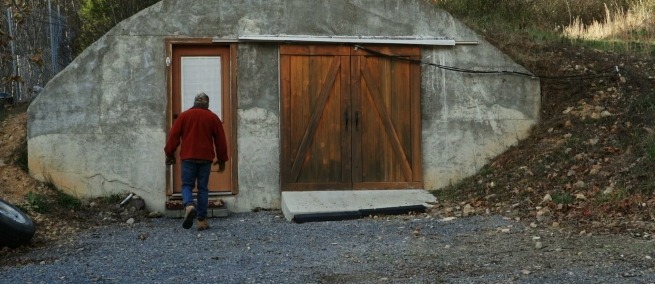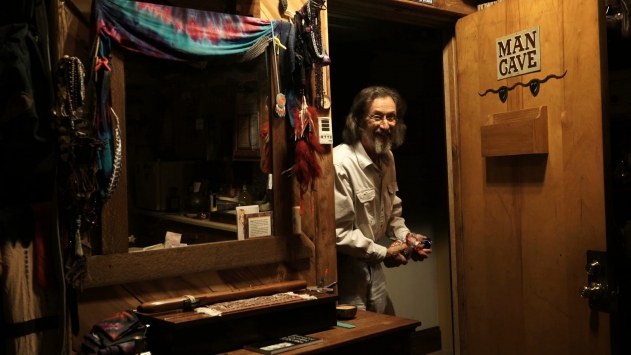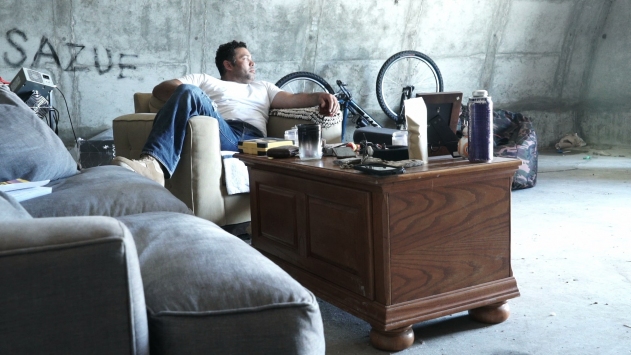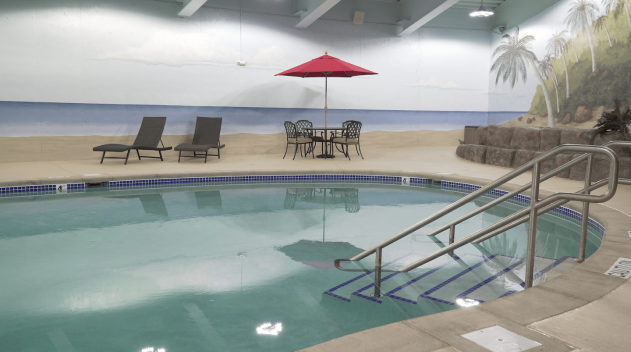
Jenny Perlin: One thing that strikes me about the men in BUNKER is about how they trust the power of vision. While shooting my film, I heard men talk many times about trusting what they see with their own eyes rather than what they hear or what they are told. This seems significant in relation to the fact that they are all living in places that cut them off from vision and other senses. How do you understand this contradiction?
Bradley Garrett: It’s an interesting observation! But in my experience what bunker dwellers are seeking is not a stilling of sensation but rather a narrowing of existential scope. Paul Virilio writes about this brilliantly in his book Bunker Archaeology, where he enters the World War II bunkers built by Germany on the beaches on Normandy during World War II and peers out from the embrasures. What you see of course is only what’s in front of you. It's assumed that from this point of view that you can stop worrying about what is behind you. The camera angles in your film seem to play this role often too, where you seem nestled in a safe corner, almost hiding. Is that off the mark?
JP: As you know, I go to these places alone and shoot all the footage myself. So you see that the camera work in BUNKER is made up of vérité style shooting, some inadvertent camera mishaps deliberately left in, and long takes. The footage also shows the size difference between me and my subjects, which I think is important and humanizes the film. Not only do you hear my voice, but you see that I can't reach up to the men’s shoulders as I'm capturing their stories on video. This is atypical of documentaries which try to efface the human behind the camera by making every shot as smooth and seamless as possible. As BUNKER continues, my voice gains more presence as I shift from being an observer to an active participant, deliberately interrupting Larry's tour. Earlier, the camera pauses, watching Ed dry and put away his cereal bowl, for example. In these long takes, I ask myself if I could live like this and what draws me to these spaces and these people. It's this ambivalent relationship to the bunker and its inhabitants that gives the camerawork its particular qualities.

Edward Peden in BUNKER by Jenny Perlin. Photo courtesy of Jenny Perlin/The Hoosac Institute.
BG: It’s certainly very effective and, watching it, I had to fess up to the fact that I have that urge to hide like them too. We are surrounded on all sides by obligations, strangers, dangers, and too much information, and I came to see these bunkers as places of solace. They don’t have to be disconnected to serve that purpose–many of these bunker enclaves you and I visited had radio communication systems and even neighbors. But in contrast to the "outside world," the bunkered environment narrows the visible. There’s a danger in thinking that scaling down the scope of your existence means you can control it–obviously these preppers are still subject to ill health, social strife, political turmoil, and global disasters, but the sense of disconnection does seem to give people peace of mind in the present.
I would be interested to hear how you found the feeling of disconnection in the bunkers. For me, the first few days without internet or phone signal triggered an overwhelming sense of panic. But then I settled into a methodical routine almost wholly based on practical needs and preparation that I found soothing. It wasn’t exactly relaxing, but I enjoyed focussing on building things and solving problems with my hands and brain rather than with my computer and phone.
JP: My first experience without the everpresent signal of outside connection was with Ed at Subterra in Kansas. I stayed with him for four days there and while I had the "upstairs" apartment, meaning that only half the windows were below ground level, so there was some natural light. But no signal of any kind, and only the howling January Kansas wind to lull me to sleep. Not that I slept much.
The feeling of being out of touch felt like sinking into soft soil. It reminded me of my childhood, where the rhythm of a day is created by the activities you are doing, each of which stretches into unusual time-forms. Because I was filming Ed most of the time, I sank deeply into his rhythms. Preparing meals, chopping wood, watching the news, eating Fritos. The days felt long and busy. Ed wanted to be a good host, so the time was spent in certain demonstrations of life inside his space, whether that was listening to music or talking to me about his background on the farm or showing me different pulleys and ropes and pitchforks in his collection.

Milton Torres in BUNKER by Jenny Perlin. Photo courtesy of Jenny Perlin/The Hoosac Institute.
I did, however, find myself running up the spiral staircase on a regular basis for light and air and a break from the intensity of being underground. And for the occasional single bar of cell signal that I could use to text home and let people know I was fine.
When I went to film in the bunkers, I asked people why they wanted to survive. What they hoped to see or create after whatever catastrophe that they were expecting happened. They all told me they wanted to help people and try to build a new civilization. Yet each of these men was completely alone. How do you think these men think about survival?
BG: I think that desire is born from alienation. There’s been a lot of media coverage about ‘middle-aged white men’ feeling that they are losing ground in society. They feel that their jobs are being taken, that their expectations aren’t being met, that their hopes are languishing, unfulfilled. Like all cultural narratives, there’s a kernel of truth to much of that, but many of them are scapegoating others instead of coming to terms with the more structural reasons why things are worse for almost everyone these days.
We’re experiencing more frequent and severe natural disasters due to the climate crisis, wages are not keeping pace with inflation; technology has failed to decrease our working lives through efficiency; and many people are priced out of housing and medical care by greedy corporations desperate to deliver shareholder value. But instead of trying to source the root of these problems, which is complicated and arduous, some preppers seem content to misplace blame, and then seek to break the system and start over.
It’s unfortunate that many of them are choosing to check out rather than using their time and resources to try to fix society, but I’m sure many people who have struggled to maintain their identity in the face of rapid change can understand the inclination to just throw up their hands and start over.
What surprised me about many bunker-builders is precisely what you point out: they see another world on the other side of this impending disaster. If we can get a conversation going between these different stakeholders about what that would look like, then the methodologies behind their ‘preps’ might transform into catalysts for fixing what’s broken.

BUNKER by Jenny Perlin. Photo courtesy of Jenny Perlin/The Hoosac Institute.
JP: Recently my Twitter feed was full of my people freaking out about the nuclear reactor in Ukraine being on fire. Which later turned out not to be true. The tragedy of Russia's attack on Ukraine feels both horrifying and unsurprising to me as both a child of the Cold War and as a person who has spent time with men living in bunkers. Of course now I am getting emails from the bunker businesses telling me that it's the right time to buy because of the situation in Ukraine. But a month ago it was because of Covid. And before that it was North Korea and the climate catastrophe. Do you think there is something specific about the United States and its history or its relative distance from so many world conflicts that makes it particularly fertile ground for people who want to live in bunkers?
BG: The pitches of the dread merchants who sell these bunkers, supplies, and weapons are the problem. It’s in their interest to ramp up rhetoric in order to drive sales. What’s interesting is you almost never hear bunker-salesmen (and they’re always men) talking about community, or what comes after the event–those stories come largely from the preppers purchasing what the dread merchants have on offer.
Your film does such a beautiful job of capturing both the fervor of the sales pitch and the loneliness of preparations on the ground once the dust settles. I was really struck by the pace of your filming, particularly during interviews, where the introspection of these residents was rendered palpable. As in the scenes with Milton at xPoint where he seems to be struggling to justify some of the decisions he’s made, sitting there alone in that cold concrete shell. It seemed like many of them thought they would purchase future security, and instead found themselves turning toward the life of the mind in relative isolation. There were so many unfinished projects, but it didn’t seem to matter, because they had already escaped in some way.
JP: We wound up traveling to so many of the same places. Are there other bunkers you wish you’d seen but didn't? And how did you come to the places you chose?
BG: I was floored when I met you and realized we had been shadowing each other without knowing it. I spent the better part of 2017 trying to find diverse bunkers: solitary, communal, budget and blockbuster. Ultimately though, as a cultural geographer, I’m driven by human stories. You seem to be too. Your film highlights loss, empathy, and hope. I always thought these bunkers without people in them would just be tombs. What your film does, in a way a book never quite can, is to expose the weird layers of humanity that turn spaces into places. Do you feel if they were building boats instead of bunkers, you still would have latched on to these characters?
JP: A large part of my fascination with these spaces is their dual purpose. A missile silo becoming a New Age paradise; a hand-built steel shipping container becoming a space that awaits its inhabitants in a random Michigan field. I agree with you that without people, these spaces are tombs. But they also seem like the people living in them have entombed themselves while they wait for a disaster that may never come in their lifetime. The fascination for me is in the stasis and the intense narrativizing of this imagined life. It's such an enormous amount of physical and mental work to live in a bunker. But the inhabitant never moves or leaves. To me, this contradiction parallels a narrative of America that presents a fantasy of rootless cowboy life in contrast to the stasis in bunker living, in home-as-castle, gated communities or other enclaves representing security, privacy, and self-sufficiency.
I get asked a lot of questions about what it was like going to these places as a woman, and about my fears, many of which are implied but not named. What kinds of questions do you get, as a man?
BG: At times I felt extremely uncomfortable, on the verge of driving away and never returning, so I can’t imagine what you felt. For me, part of that had to do with a feeling of inadequacy, being an academic who isn’t particularly "handy" to have around. But I was also scared of being labeled a liberal and chided, or even attacked. Those feelings were unfounded, as it turned out, but I did catch myself trying to be a bit more rough-and-ready in their company. I have a feeling if either of us were gun-toting republican mechanics, we would have had a much easier time. In the end though, the defenses they build won’t hold up unless they can grow, nurture, build community, and be a steward for that better future they imagine, and I think a lot of them are coming to that realization.
JP: I will say, the second trip, when I went to South Dakota, I swapped out my compact car rental for a huge pickup truck with Utah plates and got a lot more respect. But my main experience is that people in the film, like people anywhere, wanted to be portrayed honestly, not as caricatures. You did this in your book and I think that spirit is similar in the film. I'm so glad we met and have shared these conversations.
BG: Me too, it’s been quite a journey!
♦
TOPICS